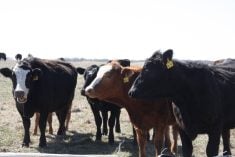This cattle market information is selected from the weekly report from Canfax, a division of the Canadian Cattlemen’s Association. More market information, analysis and statistics are available by becoming a Canfax subscriber by calling 403-275-5110 or at www.canfax.ca.
Futures close higher
United States cut-out values rebounded to a multi-year high last week, as the beef supply chain scrambled to restock retail inventories during recent COVID-19 panic buying. Cattle futures were volatile but closed higher on increased beef demand and strengthening U.S. fed cash prices.
Read Also

Trump’s tariffs take their toll on U.S. producers
U.S. farmers say Trump’s tariffs have been devastating for growers in that country.
Later-week market strength spilled into the Canadian market. Live sales started last week $1-$3 per hundredweight higher than the previous week, from $142.25-$144 per cwt. Early dressed sales were reported at $242-$243.50 per cwt., delivered, and prices firmed to $248 per cwt., delivered, on March 19.
Dress prices were generally $5-$7 per cwt. higher than the previous week and weighted average prices closed $4 per cwt. higher on a live basis.
The cash-to-futures basis weakened significantly last week and U.S. buying interest was reported.
Western Canadian steer carcass weights for the week ending March 14 eased two pounds lower than the previous week and were fully steady with the same week last year. Western Canadian fed slaughter was one percent larger than the previous week at 39,678 head. Year-to-date fed slaughter was five percent larger at 391,454 head.
Canadian fed cattle/slaughter cow exports to the U.S. for the week ending March 7 were three percent lower than the previous week at 10,336 head and year-to-date were 10 percent larger totalling 98,638 head.
The Ontario fed market continued sluggish last week with scattered dressed trade reported at $235 per cwt. delivered.
Potential disruptions to packer production during the coronavirus pandemic have added significant risk to the fed cattle market but strong underlying fundamental price support should seasonally shift some leverage toward the feeder.
Empty retail store shelves were being restocked and increased global export demand is anticipated relative to COVID-19 and the recently forgotten African swine fever epidemic. Market ready supplies are expected to tighten and spring grilling purchases should develop.
In the U.S., trade was scattered and a stronger price was noted late in the week. Dressed sales started out at US$170 per cwt. but by mid-week, most were reported at $175-$176. Dressed sales were steady to $1 per cwt. higher than the previous week. The bulk of live sales ranged from $110-$113 per cwt., steady to $3 higher than the previous week.
U.S. steer carcass weights averaged 903 lb., 32 lb. larger than last year and 23 lb. larger than the five-year average. From their high in early January, cow slaughter volumes are now below year-ago levels.
Cows at new lows
Butcher cow prices historically strengthen into spring but that has not been the case for Western Canada as new annual lows were set last week. D2 cows in the West traded at $80-$93 per cwt. to average $84.83 and D3s traded at $68-$82, averaging $74.86 per cwt. Slaughter bulls averaged $105.67 per cwt.
Ontario cow prices traded $9-$11 per cwt. higher, the first time since June that Ontario cow prices have been at a premium to the Alberta market.
On a cash-to-cash basis, the price spread between Alberta and the U.S. has also narrowed in recent weeks. Alberta cow prices are at risk of going to a discount against the U.S. utility cow market.
Despite light non-fed numbers through commercial auction facilities, cow slaughter volumes have been larger than expected. Western Canadian cow slaughter for the week ending March 14 totalled 8,695 head, the second largest weekly cow slaughter in mid-March over the past decade.
Last week, there were photos and reports of empty retail meat shelves across North America as consumers stocked up. Near-term panic buying remains supportive but there is concern that as sporting and social events are cancelled and temporary layoffs occur, this will be more negative in the long term.
Feeders take a hit
It was a tough week for all classes of cattle with prices dropping around $10-$20 per cwt. Alberta heifers weighing 900 lb. or more are trading at the lowest point since October 2016 while same-weight steers are at the lowest since January 2014.
With a sharp price pullback last week, many producers postponed hauling cattle to town and a few cattle were also passed on at electronic sales. Alberta, Saskatchewan and Manitoba auction volumes totalled more than 27,811 head, down 55 percent compared to the same week last year.
Feedlot margins have been negative but they are not alone as many backgrounding operations are looking at red ink as well. In some cases, backgrounders are selling their feeders for the same amount of money they bought them for during the fall, suggesting they gave away their feed and labour.
On the flip side, some backgrounding operators are fighting the market. Some feeder cattle that would traditionally be sold in March and April are instead being put on full feed and will be finished.
Alberta 850 lb. feeder basis levels weakened, going from +$5.80 to -$10.42 last week. The U.S. feeder index has been averaging in the low US$120s per cwt. based at close to an 800 lb. steer. Using a 69-cent Canadian dollar, this would put the 800 lb. U.S. steer price in the mid $170s per cwt. in Canadian dollars. Western Canadian feeder prices are at a large enough discount that export interest has already picked up.
U.S. cutouts rally
In U.S. beef trade, cut-out prices rallied sharply higher last week with the Choice value hitting the highest level since June 2017, averaging $249.87. Select averaged $241.06. Good demand was reported all of last week despite a heavy offering.
Spring beef demand should seasonally gain momentum. Cut-out values are expected to stabilize as retail shelves are restocked.














